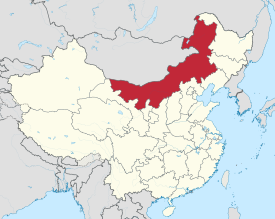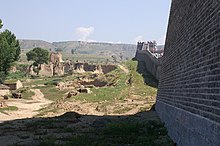Inner Mongolian culture
|
Inner Mongolia Autonomous Region Nei Mongol Autonomous Region Chinese: 內蒙古自治區 
|
|
|---|---|
| Autonomous region | |
| Name transcription(s) | |
| • Abbreviation | NM / 内蒙 or 内蒙古 (Nèiměng or Nèiměnggǔ) |
 Map showing the location of Inner Mongolia |
|
| Coordinates: 44°N 113°E / 44°N 113°ECoordinates: 44°N 113°E / 44°N 113°E | |
| Named for | From the Mongolian öbür monggol, where öbür means the front, sunny side of a barrier (a mountain, mountain range, lake, desert, clothes etc...) |
| Capital |
Ulanhot (1947–1949) Zhangjiakou (1950–1952; as capital of Chahar Province) Hohhot (1953–present) |
| Largest city | Chifeng |
| Divisions | 12 prefectures, 101 counties, 1425 townships |
| Government | |
| • Secretary | Li Jiheng |
| • Chairman | Bu Xiaolin |
| Area | |
| • Total | 1,183,000 km2 (457,000 sq mi) |
| Area rank | 3rd |
| Population (2010) | |
| • Total | 24,706,321 |
| • Estimate (31 December 2014) | 25,050,000 |
| • Rank | 23rd |
| • Density | 20.2/km2 (52/sq mi) |
| • Density rank | 28th |
| Demographics | |
| • Ethnic composition |
Han - 79% Mongol - 17% Manchu - 2% Hui - 0.9% Daur - 0.3% |
| • Languages and dialects | Mongolian (official),Mandarin (official), Oirat, Buryat, Dagur, Evenki, Jin |
| ISO 3166 code | CN-15 |
| GDP (2016) |
CNY 1.8 trillion USD 274 billion (15th) |
| - per capita |
CNY 73,936 USD 11,134 (5th) |
| HDI (2010) | 0.722 (high) (8th) |
| Website |
http://www.nmg.gov.cn (Simplified Chinese) |
| Inner Mongolia | |||||||||||||||||||||||||||||||||||||

Part of the Great Wall of China
|
|||||||||||||||||||||||||||||||||||||
| Chinese name | |||||||||||||||||||||||||||||||||||||
|---|---|---|---|---|---|---|---|---|---|---|---|---|---|---|---|---|---|---|---|---|---|---|---|---|---|---|---|---|---|---|---|---|---|---|---|---|---|
| Simplified Chinese | 内蒙古 | ||||||||||||||||||||||||||||||||||||
| Traditional Chinese | 內蒙古 | ||||||||||||||||||||||||||||||||||||
| Hanyu Pinyin |
PRC Standard Mandarin: Nèiměnggǔ ROC Standard Mandarin: Nèiménggǔ |
||||||||||||||||||||||||||||||||||||
| Literal meaning | Inner Mongolia | ||||||||||||||||||||||||||||||||||||
|
|||||||||||||||||||||||||||||||||||||
| Mongolian name | |||||||||||||||||||||||||||||||||||||
| Mongolian Cyrillic | Өвөр Монгол (Övör Mongol) |
||||||||||||||||||||||||||||||||||||
| Mongolian script | ᠦᠪᠦᠷ ᠮᠤᠩᠭᠤᠯ |
||||||||||||||||||||||||||||||||||||
|
|||||||||||||||||||||||||||||||||||||
| Transcriptions | |
|---|---|
| Standard Mandarin | |
| Hanyu Pinyin |
PRC Standard Mandarin: Nèiměnggǔ ROC Standard Mandarin: Nèiménggǔ |
| Bopomofo |
PRC: ㄋㄟˋ ㄇㄥˇ ㄍㄨˇ ROC: ㄋㄟˋ ㄇㄥˊ ㄍㄨˇ |
| Gwoyeu Romatzyh |
PRC: Ney Meengguu ROC: Ney Mengguu |
| Wade–Giles |
PRC: Nei4 Mêng3-ku3 ROC: Nei4 Mêng2-ku3 |
| Tongyong Pinyin |
PRC: Nèi Měnggǔ ROC: Nèi Ménggǔ |
| Yale Romanization |
PRC: Nèiměnggǔ ROC: Nèiménggǔ |
| MPS2 |
PRC: Nèi Měnggǔ ROC: Nèi Ménggǔ |
| IPA | [nêi mə̌ŋ.kù] |
| Wu | |
| Romanization | Nga Mongu |
| Yue: Cantonese | |
| Yale Romanization | Noih Mùhnggú |
| IPA | [nɔ̀ːi mʊ̏ŋ kǔː] |
| Jyutping | noi6 mung4 gu2 |
| Southern Min | |
| Hokkien POJ | Lāi-bông-kó |
| Transcriptions | |
|---|---|
| SASM/GNC | Öbür Monggol |
| Nei Mongol Autonomous Region | |||||||||||||||||||||||||||||||||||||
| Chinese name | |||||||||||||||||||||||||||||||||||||
|---|---|---|---|---|---|---|---|---|---|---|---|---|---|---|---|---|---|---|---|---|---|---|---|---|---|---|---|---|---|---|---|---|---|---|---|---|---|
| Simplified Chinese | 内蒙古 | ||||||||||||||||||||||||||||||||||||
| Traditional Chinese | 內蒙古 | ||||||||||||||||||||||||||||||||||||
| Hanyu Pinyin |
PRC Standard Mandarin: Nèi Měnggǔ Zìzhìqū ROC Standard Mandarin: Nèi Ménggǔ Zìzhìqū |
||||||||||||||||||||||||||||||||||||
| Literal meaning | Inner Mongolia Autonomous Region | ||||||||||||||||||||||||||||||||||||
|
|||||||||||||||||||||||||||||||||||||
| Mongolian name | |||||||||||||||||||||||||||||||||||||
| Mongolian Cyrillic | Өвөр Монголын Өөртөө Засах Орон (Övör Mongolyn Öörtöö Zasakh Oron) |
||||||||||||||||||||||||||||||||||||
| Mongolian script | ᠦᠪᠦᠷ ᠮᠣᠩᠭᠤᠯ ᠤᠨ ᠥᠪᠡᠷᠲᠡᠭᠡᠨ ᠵᠠᠰᠠᠬᠣ ᠣᠷᠣᠨ |
||||||||||||||||||||||||||||||||||||
|
|||||||||||||||||||||||||||||||||||||
| Transcriptions | |
|---|---|
| Standard Mandarin | |
| Hanyu Pinyin |
PRC Standard Mandarin: Nèi Měnggǔ Zìzhìqū ROC Standard Mandarin: Nèi Ménggǔ Zìzhìqū |
| Bopomofo |
PRC: ㄋㄟˋ ㄇㄥˇ ㄍㄨˇ ㄗˋ ㄓˋ ㄑㄩ ROC: ㄋㄟˋ ㄇㄥˊ ㄍㄨˇ ㄗˋ ㄓˋ ㄑㄩ |
| Gwoyeu Romatzyh |
PRC: Ney Meengguu Tzyhjyhchiu ROC: Ney Mengguu Tzyhjyhchiu |
| Wade–Giles |
PRC: Nei4 Mêng3-ku3 Tzŭ4-chih4-chʻü1 ROC: Nei4 Mêng2-ku3 Tzŭ4-chih4-chʻü1 |
| Tongyong Pinyin |
PRC: Nèi Měnggǔ Zìhjhìhcyu ROC: Nèi Ménggǔ Zìhjhìhcyu |
| Yale Romanization |
PRC: Nèi Měnggǔ Dz̀jr̀chyū ROC: Nèi Ménggǔ Dz̀jr̀chyū |
| MPS2 |
PRC: Nèi Měnggǔ Tz̀jr̀chiū ROC: Nèi Ménggǔ Tz̀jr̀chiū |
| IPA | [nêi mə̌ŋ.kù tsɹ̩̂.ʈʂɻ̩̂.tɕʰý] |
| Wu | |
| Romanization | Nga Mongu Zyzychiu |
| Yue: Cantonese | |
| Yale Romanization | Noih Mùhnggú Jihjihkeuī |
| IPA | [nɔ̀ːi mʊ̏ŋ kǔː tɕìːtɕìːkʰɵ́y] |
| Jyutping | noi6 mung4 gu2 zi6zi6keoi1 |
| Southern Min | |
| Hokkien POJ | Lāi-bông-kó Chū-tī-khu |
| Transcriptions | |
|---|---|
| SASM/GNC | Öbür mongγol-un Öbertegen Zasaqu Orun |
Inner Mongolia (Mongolian: ![]() in Mongolian script, Mongolian Cyrillic: Өвөр Монгол, romanization: Öbür Monggol; simplified Chinese: 内蒙古; traditional Chinese: 內蒙古; pinyin: Nèiměnggǔ), officially the Inner Mongolia Autonomous Region or Nei Mongol Autonomous Region, is an autonomous region of China, located in the north of the country, containing most of China's border with Mongolia (the rest of the China-Mongolia border is taken up by the Xinjiang autonomous region and Gansu province) and a small section of the border with Russia. Its capital is Hohhot, and other major cities include Baotou, Chifeng, and Ordos.
in Mongolian script, Mongolian Cyrillic: Өвөр Монгол, romanization: Öbür Monggol; simplified Chinese: 内蒙古; traditional Chinese: 內蒙古; pinyin: Nèiměnggǔ), officially the Inner Mongolia Autonomous Region or Nei Mongol Autonomous Region, is an autonomous region of China, located in the north of the country, containing most of China's border with Mongolia (the rest of the China-Mongolia border is taken up by the Xinjiang autonomous region and Gansu province) and a small section of the border with Russia. Its capital is Hohhot, and other major cities include Baotou, Chifeng, and Ordos.
The Autonomous Region was established in 1947, incorporating the areas of the former Republic of China provinces of Suiyuan, Chahar, Rehe, Liaobei and Xing'an, along with the northern parts of Gansu and Ningxia. It is the third largest subdivision of China, spanning approximately 1,200,000 km2 (463,000 sq mi) or 12% of China's total land area. It recorded a population of 24,706,321 in the 2010 census, accounting for 1.84% of Mainland China's total population. Inner Mongolia is the country's 23rd most populous province-level division. The majority of the population in the region is Han Chinese, with a sizeable titular Mongol minority. The official languages are Mandarin and Mongolian, the latter of which is written in the traditional Mongolian script, as opposed to the Mongolian Cyrillic alphabet, which is used in the state of Mongolia.
...
Wikipedia
